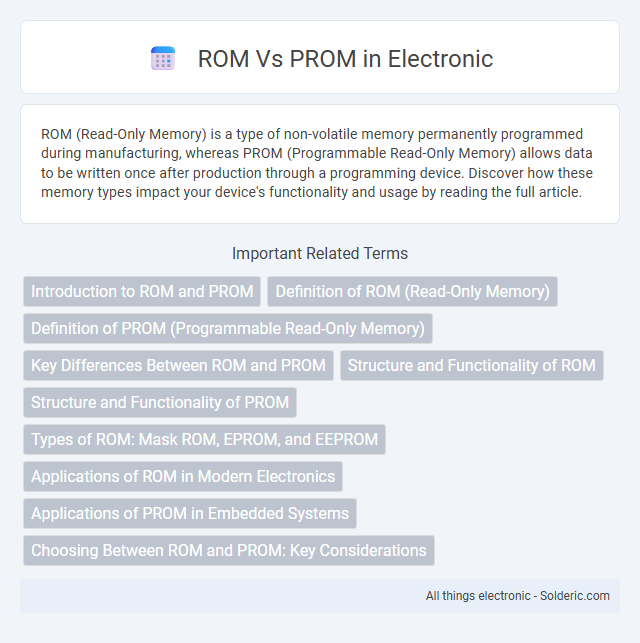ROM (Read-Only Memory) is a type of non-volatile memory permanently programmed during manufacturing, whereas PROM (Programmable Read-Only Memory) allows data to be written once after production through a programming device. Discover how these memory types impact your device's functionality and usage by reading the full article.
Comparison Table
| Feature | ROM (Read-Only Memory) | PROM (Programmable Read-Only Memory) |
|---|---|---|
| Definition | Non-volatile memory pre-written during manufacturing. | One-time programmable memory created by the user. |
| Programmability | Programmed by manufacturer only. | User programs once after manufacturing. |
| Data Modification | Cannot be modified or erased. | Cannot erase or reprogram after initial use. |
| Usage | Stores firmware, bootloader, fixed code. | Custom code storage for prototypes and low-volume products. |
| Cost | Lower unit cost at high volumes. | Higher cost per unit due to user programming. |
| Flexibility | Low, fixed at production. | Moderate, one-time configurable. |
| Examples | Mask ROM | EPROM, EEPROM |
Introduction to ROM and PROM
ROM (Read-Only Memory) is a type of non-volatile memory used in computers and electronic devices to store firmware or permanent data that cannot be modified during normal operation. PROM (Programmable Read-Only Memory) is a subtype of ROM that allows data to be written once after manufacturing, making it customizable for specific applications. Understanding the differences in programmability between ROM and PROM helps you select the appropriate memory type for firmware storage and hardware configuration.
Definition of ROM (Read-Only Memory)
ROM (Read-Only Memory) is a type of non-volatile memory used in computers and electronic devices to store firmware or permanent data that cannot be easily modified or erased by the user. It retains its contents even when the device is powered off, making it essential for boot processes and fundamental system instructions. Unlike PROM (Programmable Read-Only Memory), which can be programmed once after manufacturing, ROM is typically pre-written during the manufacturing process and remains unchanged.
Definition of PROM (Programmable Read-Only Memory)
PROM (Programmable Read-Only Memory) is a type of non-volatile memory that can be programmed once after manufacturing, allowing data to be written using a special device called a programmer. Unlike ROM, which is pre-written during the manufacturing process, PROM enables customization by users or developers to store permanent data or firmware. Your choice between ROM and PROM depends on whether fixed or user-defined data storage is required for your specific application.
Key Differences Between ROM and PROM
ROM (Read-Only Memory) is non-volatile memory pre-programmed during manufacturing, while PROM (Programmable Read-Only Memory) allows your device's data to be written once after production using a special programmer. ROM contains fixed data that cannot be modified, whereas PROM can be customized but becomes permanent after programming. Key differences include flexibility in data writing, cost, and application suitability in embedded systems versus customizable firmware updates.
Structure and Functionality of ROM
Read-Only Memory (ROM) consists of non-volatile semiconductor memory chips designed to store firmware or permanent data that cannot be easily altered, ensuring consistent system startup and operation. Programmable ROM (PROM) is a type of ROM that allows one-time programming after manufacturing, making it customizable but immutable once written. Your system's firmware relies on the structure and functionality of ROM to maintain critical instructions even when power is lost.
Structure and Functionality of PROM
PROM (Programmable Read-Only Memory) consists of an array of fusible links or programmable cells that can be selectively burned or altered once after manufacturing to store data permanently. Its structure enables data to be written only once by the user, making it non-volatile memory ideal for firmware that does not require modification. Unlike traditional ROM, whose data is inscribed during fabrication, PROM offers customizable functionality by allowing post-production programming.
Types of ROM: Mask ROM, EPROM, and EEPROM
ROM types include Mask ROM, which is permanently programmed during manufacturing and cannot be altered; EPROM, allowing data to be erased with UV light and reprogrammed multiple times; and EEPROM, enabling electrical erasure and reprogramming at the byte level for versatile use. Each type serves different purposes in embedded systems, firmware storage, and device boot processes based on update frequency and flexibility requirements. Your choice of ROM impacts system design, longevity, and ease of firmware updates.
Applications of ROM in Modern Electronics
ROM (Read-Only Memory) is integral to embedded systems, firmware storage, and bootloader programs in modern electronics, ensuring reliable, non-volatile data retention across devices like smartphones, computers, and automotive control units. Unlike PROM (Programmable Read-Only Memory), ROM is pre-programmed during manufacture, enabling fast access to essential code for system initialization and secure execution. Its applications extend to consumer electronics, industrial machines, and medical devices where consistent, tamper-proof software performance is critical.
Applications of PROM in Embedded Systems
PROM (Programmable Read-Only Memory) is extensively used in embedded systems for storing firmware that requires infrequent updates after manufacturing. It provides a cost-effective solution for applications such as microcontroller boot code, calibration data, and device configuration settings. PROM's one-time programmability ensures data integrity and security in critical embedded control systems.
Choosing Between ROM and PROM: Key Considerations
Choosing between ROM and PROM depends on the need for customization and permanence; ROM is pre-programmed during manufacturing and ideal for stable, unchanging software, while PROM allows one-time user programming after production, offering flexibility. Consider the application environment--ROM suits mass-produced devices requiring consistent firmware, whereas PROM serves prototyping or updates without expensive mask changes. Cost-effectiveness also plays a role, with ROM typically having higher upfront design costs but lower per-unit expense compared to PROM's moderate initial cost paired with user programmability.
ROM vs PROM Infographic

 solderic.com
solderic.com